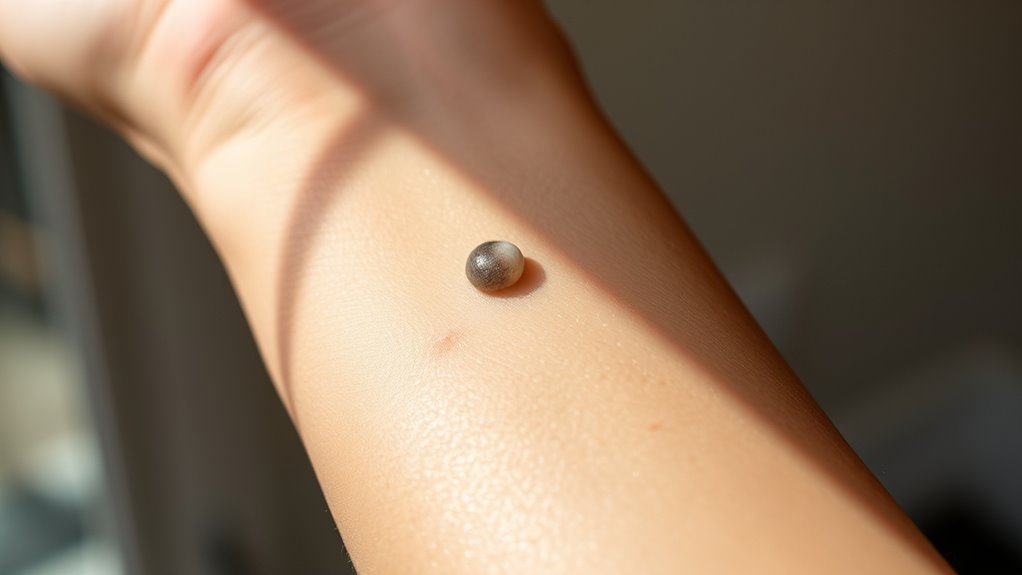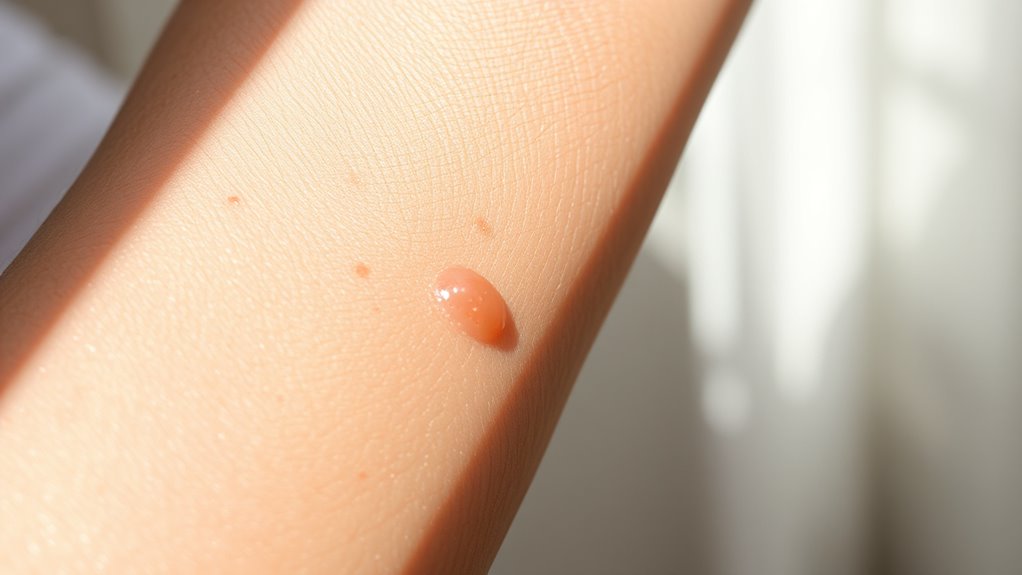To spot early signs of skin cancer, regularly check your skin using a mirror and good lighting. Look for new or changing moles, especially those with irregular borders, multiple colors, or asymmetry. Pay attention to sores that won’t heal or patches that change shape or color. Focus on sun-exposed areas and hard-to-see spots like behind ears and soles of your feet. Keep an eye out for anything unusual—if you notice something suspicious, you’re close to learning what steps to take next.
Key Takeaways
- Use good lighting and a mirror, and ask a partner to help examine hard-to-see areas like back and scalp.
- Look for moles with irregular borders, multiple colors, asymmetry, or recent size and shape changes.
- Focus on sun-exposed areas such as face, neck, arms, and legs for new or changing spots.
- Watch for lesions that won’t heal, unusual growths, or pigmented patches that change over time.
- Schedule a dermatologist appointment promptly if you notice any suspicious skin changes or concerning moles.

Have you ever wondered how to spot early signs of skin issues from the comfort of your home? Conducting a DIY skin check is a smart way to stay proactive about your health. Start by examining your skin carefully, paying close attention to moles. A mole examination involves looking for any changes in size, shape, color, or texture. Use a mirror or ask a partner to help you inspect hard-to-see areas like your back and scalp. Keep an eye out for moles that have irregular borders, multiple colors, or appear asymmetrical. These can be warning signs that you should have a healthcare professional evaluate further. Remember, early detection is key to catching skin cancer in its earliest stages when treatment is most effective. Incorporating self-examinations into your routine can help you recognize suspicious changes promptly. Sun protection plays a pivotal role in preventing skin issues and should be part of your routine even when you’re just doing a skin check. Check your skin for areas that have been exposed to the sun frequently, such as your face, neck, arms, and legs. If you notice new spots or changes in existing moles, consider how much sun exposure you’ve had recently. Protecting your skin from harmful UV rays reduces the risk of developing skin cancer. Make sure you’re using broad-spectrum sunscreen with at least SPF 30 daily, even on cloudy days, and reapply it every two hours when outdoors. Wearing protective clothing, wide-brimmed hats, and seeking shade during peak sun hours also helps minimize UV damage. When doing your skin check, take note of any areas that seem more sun-damaged or have developed new pigmentation. Beyond moles, examine your entire body for any unusual growths, sores that won’t heal, or pigmented patches that change over time. Use good lighting and a mirror to look at your back, behind your ears, and the soles of your feet. Be especially vigilant for lesions that are asymmetric, have uneven borders, multiple colors, or are larger than a pencil eraser—these are common features of potential skin cancers. If you spot anything suspicious, don’t ignore it. Schedule a visit with a dermatologist for a professional mole examination. Regular self-checks, combined with sun protection habits, can considerably reduce your risk of serious skin issues. Staying attentive to your skin’s health empowers you to catch problems early and seek treatment promptly.
Frequently Asked Questions
How Often Should I Perform a Skin Self-Exam?
You should perform a skin self-exam once a month to stay on top of your skin monitoring routines. Regular self-exam frequency helps you notice any new or changing spots early. Choose a consistent time, like after a shower or bath, so it becomes part of your routine. Make sure to check all areas, including often-missed spots, so you can catch any potential issues early and seek professional advice if needed.
Can Skin Cancer Develop in Areas Not Exposed to the Sun?
Yes, skin cancer can develop in areas not exposed to the sun, like hidden skin under clothing or on your soles and palms. While sun-exposed skin is common for skin cancer, it’s important to check all areas regularly. You might not notice changes in hidden skin, so perform thorough self-exams on your entire body. Keep an eye out for unusual spots or changes, regardless of sun exposure.
What Are Common False Signs of Skin Cancer?
False signs of skin cancer often include benign moles that look unusual but aren’t harmful. Skin aging can also cause changes like age spots or rough patches, which might be mistaken for cancer. You might notice irregular borders or uneven color, but these could be benign. It’s important to remember that not every change is dangerous, but regular check-ups help distinguish harmless signs from actual skin cancer.
Should I Use Any Special Tools During My Skin Check?
Imagine you’re in a time before modern tools—now, you can enhance your skin check with a skin magnifying glass to see tiny changes more clearly. A UV flashlight isn’t necessary for routine checks, as it’s mainly used by professionals. Focus on good lighting, a mirror, and your eyes. These simple tools help you spot suspicious spots early, making your self-exam more effective and giving you peace of mind.
When Should I See a Dermatologist After a DIY Skin Check?
If you notice any suspicious lesion during your DIY skin check, you should see a dermatologist promptly. A dermatologist consultation helps with suspicious lesion evaluation, ensuring early detection of potential skin cancer. Don’t wait if a mole changes shape, color, or size, or if a new, unusual growth appears. Regular dermatologist visits are essential for ongoing skin health, especially if you’re at higher risk or notice concerning changes.
Conclusion
Performing regular skin checks can save your life, catching early signs of skin cancer before it spreads. Remember, one in five Americans will develop skin cancer in their lifetime, but early detection dramatically increases treatment success. By staying vigilant and doing these simple checks, you’re taking control of your health. Don’t wait—trust your instincts, and see a doctor if you notice any changes. Your proactive steps today could make all the difference tomorrow.









